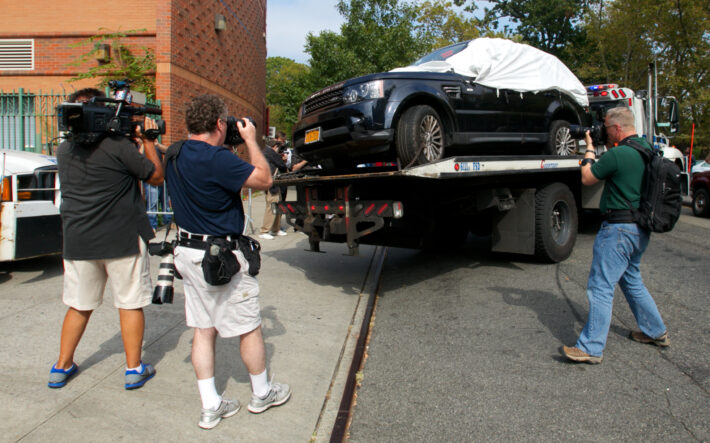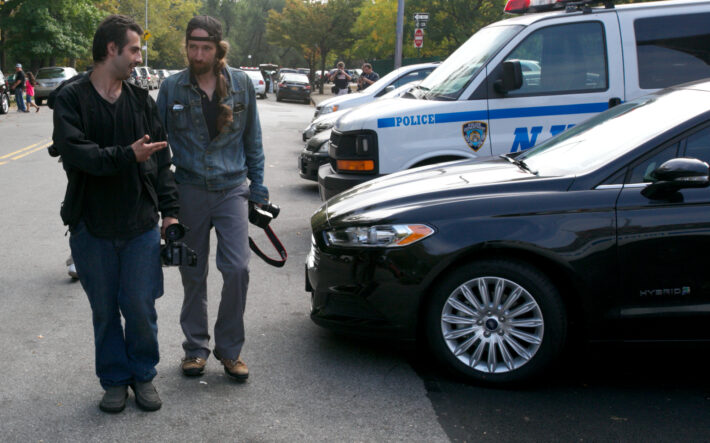
Freelance crime reporter David Greene arrived at Washington Heights’ 33rd Police Precinct at 2 a.m., hoping to photograph a motorcyclist accused of smashing the window of a sport utility vehicle in a recent road rage incident on the west side of Manhattan.
By noon Greene was still hoping, waiting to take that photo, as he smoked yet another cigarette.
“Personally, I hate stakeouts,” said Greene, 49, who stood slender, tall and ponytailed in yesterday’s clothes. “I don’t like to be on a job for more than two or three hours.”
But the opportunity was too big to miss: One of several posted videos of the incident, where as many as six motorcyclists beat up the driver while sparing his wife and daughter, had more than 1.8 million hits. Some police officers were among the bikers and allegedly witnessed the attack, all of which convinced Greene to forego covering two accidents, a homicide and a drowning for the chance to photograph the smashed SUV or the suspect.
“It is an international story, so maybe I can sell it overseas,” he said, looking rather pale after the long night. Greene said he had eaten breakfast but admitted, “I’d feel better if I had had some sleep.”
Little or no sleep is just one of the many hassles crime reporters face. Reporters like Greene also face the challenge of dealing with the Deputy Commissioner, Public Information’s office, and DCPI is notorious for stonewalling on information requests.
And yet, thanks to the efforts of a Bronx-based reporter and a Bronx city council member, that relationship may be about to improve, at least somewhat: Legislation passed last April calls for a public, neighborhood-specific crime database that should be operational in the next few months.
Chasing the news
In the meantime, armed with a police scanner, a camera and a voice recorder, Greene drives around New York chasing murders, assaults, accidents and fatalities that he deems newsworthy.
During the week he reports for community weekly newspapers like the Bronx Times and the Norwood News. On the weekends, he waits for the crazy bar fights and late night shootings that pay the bills every month, knowing that he will get depressed if he misses a story or the “money shot.”
“Why do I do it? I don’t know. I wish I knew. I think I’m a… what do you call it? I love pain,” said Greene, a former driving instructor who had his students drive by crime scenes so that he could take pictures. “I would [say] take a right, take a left… click, click, click,” he said with a warm smile that revealed numerous missing teeth.
People want to know what happens in their neighborhood, he believes, which is why readers are drawn to crime stories. “It’s important to get the story out there, whether it’s a fatal accident or some woman abandoning her children in the library,” said Greene, who sells primarily to community newspapers that buy stories considered too small for major publications.
Still, Greene is always on the lookout for hard news stories or pictures to sell to the New York Post, the New York Daily News or even The New York Times, if the story is big enough. That means long hours on stakeouts, and tough competition to get a quote, a sound bite or a perp’s photograph. He is many times successful, particularly with the Post and the Daily News.
Long waits
Greene was one of more than a dozen photojournalists, television and newspaper reporters waiting outside the precinct for a glimpse of the biker suspect or the SUV. Many smoked nearby; others talked and laughed together, while at least one reporter working for the Post read a book.
“Sometimes you’ll be eight hours in front of somebody’s house or two days sitting in front of a precinct,” said the reporter, who requested anonymity for fear that he could be admonished for his comments.
“The job is long periods of boredom and nothingness punctuated by seconds or moments of insanity,” said the reporter, noting that the collegial atmosphere among reporters can change in an instant. “Everybody is all nice, having a party, hanging out and telling jokes and seeing all friends they haven’t seen [since] before the last stakeout and then boom, everybody gets nasty and pushes, jockeying for positions.”
He said however, that the job “is not bad,” and there are days when he loves the work. Before he could elaborate, he noticed a number of reporters scattering for vantage positions near the area where the black SUV involved in the attack was being kept, and hurried to join them.
Authorities had said earlier in the day that police were about to tow the vehicle out of the precinct, and reporters hoped for a glimpse of its passenger side. If that side was damaged, it would suggest that motorcyclists had attacked the wife’s side of the SUV as well as the driver’s, which is a “compelling” detail, the reporter said.
Getting the details
But the towed vehicle was covered almost completely by white plastic, leaving reporters few fresh details. As the truck towed the SUV away, reporters ran after it for a good shot before it made a turn onto an adjacent street, sped up and disappeared over the horizon.
“Five seconds of work for 10 hours of wait,” said Boris Kaykov, a 29-year-old freelancer videographer whose unshaven face and bloodshot red eyes suggested a sleepless night.
Kaykov said that getting details and good shots is challenging because “you got to deal with the public, you got to deal with the cops, you got to deal with the firemen.” He also complained that at times DCPI gives preferential treatment to certain reporters at the scene, a group to which he did not belong.
Neither public, nor about information
“DCPI is called the Deputy Commission of Public Information, but it’s neither public nor about information,” said Kerry Burke, a veteran crime reporter for the New York Daily News.
The only way to work with DCPI, according to Burke, is to build personal relationships with people within department. “But frankly, when I come to cover a story, DCPI is my last stop,” he said. “I go to the scene and talk to actual police detectives; I talk to participants, witnesses, victims’ families. If you are waiting around for DCPI to give you a story, then you are definitely not going to make deadline.”
While crime rates in New York have improved substantially since the early 1990s, some reporters like Burke, who’s been on the job for 12 years, say that DCPI responsiveness to media inquires has not followed the same trend. He feels that DCPI became increasingly evasive during the Giuliani administration, 1994 through 2001, an administration that Burke described as “very controlling.” In his opinion, it’s been that way ever since.
No response
DCPI has not responded to interview and comment requests made since August. A detective, who answered an early October phone call but hung up without providing her first or last name, said that DCPI offices are not open to public visits.
DCPI does not provide response estimates because of the high number of requests they get. According to its site, DCPI gets between 600 and 1,000 telephone calls from reporters on weekdays, and several hundred per day on the weekend.
Alex Kratz, editor of the Bronx-based community newspaper Norwood News, used to get neighborhood crime statistics from his precinct commander in minutes, but that changed in December of 2008 when the commander was told by the DCPI to stop providing the reports.
Kratz was instructed to file Freedom of Information Act requests to DCPI by regular mail, even though he once had to wait 18 months to get these reports, which he says are more comprehensive than the precinct-wide crime reports found online. His most recent request for neighborhood crime reports was filed late last January. Over nine months later, he is still waiting.
“The NYPD is the worst in terms of getting public information out from any agency in New York City,” said Kratz, adding the next in line in terms of lack of cooperation, in his opinion, are the Department of Environmental Protection and the Department of Education.
Hope for change
Norwood News has publicized for years how long it takes to get neighborhood crime reports. The newspaper even put a ticking clock on its website, noting the days since the most recent request filing. Then, in Oct. 2011, Bronx Councilman Fernando Cabrera took interest in the issue and introduced legislation that was approved six months ago, calling for the creation of a sector crime-mapping database. This map, which Kratz expects to be online in the next few months, will allow the public to view statistics of criminal activity at a neighborhood level for the first time.
Kratz said he hopes DCPI responsiveness will improve in terms of public information because “New York is the worst, so it can only get better.”
Burke believes that any improvement will depend on who the next mayor is, and who is picked as police commissioner. “Don’t get me wrong,” he said, “there are some fine officers over there (NYPD), but the reins are tight.”
Crime doesn’t pay
Crime reporters, particularly freelance photographers and videographers who make a living from selling exclusive content, face another obstacle, though: the Internet and improved technology. News outlets like television stations have come to rely more and more on cell phone videos and photos that onlookers, not professional journalists, submit.
Kaykov said that he has offered to buy video from crime-scene onlookers, to no avail. “And I will tell him that I’ll pay for this video…I’ll say how much do you want,” said Kaykov, raising his voice. But people tend to respond that it is not about money, telling him, “’I just want my name on T.V. so I can tell my buddies.’”
Greene, who often works with Kaykov for safety and to split gas money, said that Kaykov tells him almost every day that he is done with reporting, only to call the next day with a story tip. Kaykov admits that the hours, flexibility and independence have a strong appeal.
“You are your own boss, you don’t deal with a boss, you don’t do the same thing over and over from 9 a.m. to 5 p.m., everyday is a different game,” said Kaykov, who, like Greene, failed to make a sale from the 13-hour SUV stakeout. Still, “no matter how much I stop I always pick up again,” Kaykov said. “It’s like a drug. Once you get a little of it, you can’t stop.”
